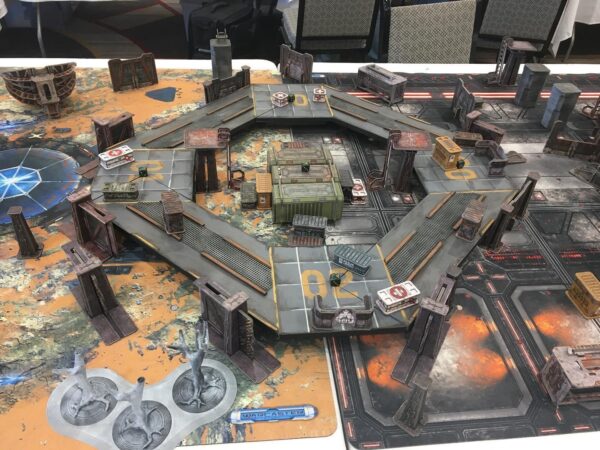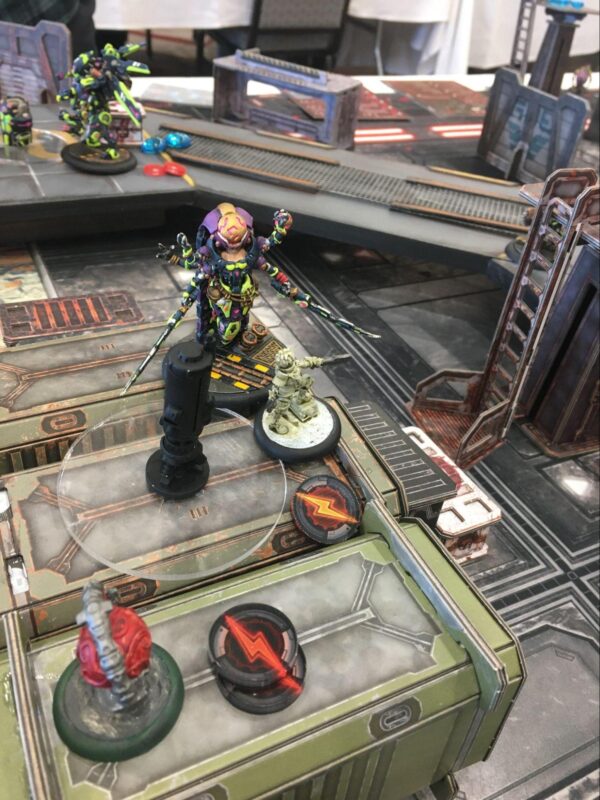
Warcaster Outpost
Unnumbered outposts stretch across the Thousand Worlds, each an anchor for humanity’s spread through the reaches of space. These are the sites where flags are planted, walls are raised, and defenders dig in, daring their rivals to force them out. They are flashpoints waiting to happen, monuments to defiance in the face of unending conflict.
They are sites of epic battles for the warring factions of Warcaster: Neo-Mechanika. For every wall and every fortress is just a challenge waiting to broken, and no place is truly safe in the Hyperuranion.
As a confession, I love playing narrative games at conventions. There’s a certain spectacle to an open gaming hall, full of excited gamers from all over the world, playing on eye-catching tables with unique scenarios and throwing wrenches into player strategies right and left. We see friends we may only see once a year, sharing laughs and dutifully destroying each other’s meticulously assembled armies.
And traditionally, everyone’s blood-caffeine levels get a bit wonky.
This is a time when Warcaster: Neo-Mechanika gets to strut its stuff as a dynamic, three-dimensional wargame. The game is arguably at its best and most beautiful when the table is covered in crates, alien trees, barricades, even multi-level platforms to give cover and a place to shoot from. Most games of Warcaster are visual feasts, with models being slammed off of towers, flying up to platforms, or just laying down twin flamethrowers and cackling like mad.
Naturally, conventions are a great setting to stage some epic battles for the armies of the Thousand Worlds. Being someone who also loves siege movies and the cinematic visuals of one army throwing themselves against the defenses of another, I knew at some point there had to be a Warcaster siege scenario.
So, this year at Warfaire Weekend in St Louis, we introduced the Outpost Assault scenario for Warcaster: Neo-Mechanika. Intended to function either as a convention event or as a demo scenario for new players, the Outpost Assault works best with a single large terrain piece in the center of the board to provide a fortress for the players to war over. The players are split into a team of Defenders, tasked with holding the base and maintaining its defensive shield, and the Attackers, who gain bonus points for claiming objectives deeper into the outpost.
The outpost pictured below was a simple build using a few pieces of leftover wood from a house renovation and some plastic canvas. The four pieces lock together with supports underneath to provide a large elevated platform to fight over, and they come apart for (hopefully) damage-free travel to and from the convention. We paired this with Warfaire Weekend’s beautiful selection of TinkerTurf terrain and a couple of Privateer Press battlemats, and within minutes we had a battlefield!
For Warfaire Weekend, we played Outpost Assault using the Modified Skirmish rules from the Pendulum event packet, giving each player up to 11 units and two Hero selections for their forces.
The scenario revolved around the outpost’s shields, with five control terminals arranged within its armored walls. The shield acted as a scrambler for the Attacker’s warcaster, denying them the ability to place Void Gates inside the base while the shield is up. This made for a thrilling first Pulse Round, as the Attackers went for several control terminals at once to try to bring the shield down, but the dogged Defenders held their ground and kept their base intact.
The second Pulse Round saw a daredevil play from the Attackers, focusing on two objectives before rushing forward and putting a Divine Tempest into play to contest the valuable center objective! It gave them just enough of an edge to bring the shields down and start racking up points from the middle, holding on to their lead through the third Pulse Round and into a victory!
If you’d like to play the Outpost Assault scenario yourselves, the rules are included below for your gaming table or local game store get-together. While we played it at Modified Skirmish for this event, it scales down to Skirmish level if you want to get some practice games or demos in, and up to Primary if you really want to cut loose with your whole collection on the four-player map. Now get out there and seize (or defend) your own piece of the Hyperuranion!
* * * *
SETUP
The Outpost Assault scenario is meant to be played by four players on two 36″ × 36″ boards. For a smaller two-player game, this can be reduced to a single 36″ × 36″ board.
Place one permanent objective in the center of the board and four permanent objectives as shown on the map. These represent the Control Terminals and do not provide cover. The outpost is defined by a square connecting the outer four objectives. In a two-player scenario, split the outpost in half and discard the objective on the unused half.
Players are not required to use a terrain set piece as described above, but the outpost should consist of platforms for elevation and plenty of cover for the Defender.
The Defender deploys and acts first, with the entirety of the outpost as described above acting as their deployment zone for this scenario. The Attackers share two deployment zones 10″ from each edge of the board and may use either or both zones. In a two-player scenario, the Attacker’s deployment zone extends 10″ from the edge opposite the outpost.
SPECIAL RULES
Only warrior models may score objectives.
Arc Shield: The Defenders have an Arc Shield erected around the outpost, which only their warcaster has attuned to. While the shield is online, the Attackers may not place Void Gates within the outpost. The shield is online while the Attackers control one or fewer Control Terminals.
Since the outpost is also the Defender’s deployment zone, the Defender may always choose to place Void Gates within the outpost, regardless of whether the shield is online or offline.
If the Attackers control two or more Control Terminals, the shield is immediately taken offline, and the Attacker player may place Void Gates as normal. If at any point, if the Attacker controls fewer than two Control Terminals, the shield immediately comes online and all Attacker Void Gates within the outpost collapse.
SCORING
Players score Victory Points at the end of each Pulse Round for each objective they secure. Each objective is worth 1 VP. The center objective is worth 3 VP to the Attacker.
VICTORY CONDITIONS
After the third Pulse Round is scored, the player with the most Victory Points wins the game.
Our thanks to War Budgies for their contribution!
The post Warcaster Outpost appeared first on Privateer Press.



